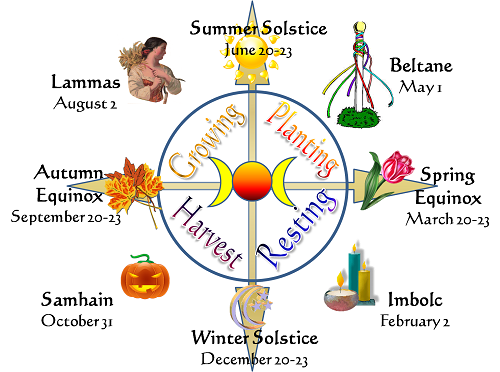 One of the sources of Unitarian Universalism is "Spiritual teachings of Earth-centered traditions which celebrate the sacred circle of life and instruct us to live in harmony with the rhythms of nature." This reflects a basic source of contemporary Paganism, too.
One of the sources of Unitarian Universalism is "Spiritual teachings of Earth-centered traditions which celebrate the sacred circle of life and instruct us to live in harmony with the rhythms of nature." This reflects a basic source of contemporary Paganism, too.
Modern Paganism draws from many cultures and traditions. One major influence is from European Earth-centered traditions celebrating the Wheel of the Year.
The following eight holidays, or Sabbats, mark the seasons of the Sun -- the Solstices, Equinoxes, and points in between in European traditions. The dates given below are customary; the exact astronomical dates may vary. The rhythm created by our planet circling the sun reflects the ever-flowing cycle of life and death. Through the eight Sabbats, many contemporary Pagans attune themselves to the creative forces of the Cosmos.
Samhain
or Halloween (October 31)
This is the time of year the light noticeably fades. Pagans reflect on and review the past year and welcome the Celtic New Year. In this season, Pagans also honor death as a part of the sacred circle of life and remember those who have died.
Yule
the Winter Solstice (December 21)
This is the shortest day and longest night of the year. Pagans welcome the rebirth of the Sun with feasting, dancing, music and festivities. Decorations include wreaths, boughs of holly, mistletoe, evergreens, and lots of lights.
Imbolc
or Candlemas (February 2)
This is the time to celebrate the growing daylight. Pagans celebrate with candles and fire to symbolize the renewing power of the Sun's illumination in Nature and new beginnings in ourselves.
Ostara
the Spring Equinox (March 21)
On the first day of Spring, when day and night are balanced, Pagans honor that balance and seek it within while rejoicing in the stirrings of life in Nature.
Beltane
or May Day (May 1)
This is the day for dancing around maypoles in honor of the fertility of the Earth made possible by the increased warmth of the Sun.
Litha
the Summer Solstice (June 21)
On the longest day of the year, with the Sun at its highest point in the sky, Pagans rejoice in the Sun's life-giving warmth and ability to make things grow.
Lammas
or Lughnasad (August 1).
This is the time of year when plants first start to drop their fruits or seeds. With the days growing shorter, Pagans celebrate the bounty of the Earth with the first harvests of grains.
Mabon
the Autumn Equinox (September 21)
Again the days and nights are of equal length and Pagans acknowledge the balance. This inaugurates a season of preparation and the transition from the ease of summer to the colder tasks of winter.
Through the joyous and thoughtful celebration of the rhythms of the solar cycle, we are reminded of our connection with each other and with All There Is. With Unitarian Universalists, Pagans affirm and promote "Respect for the interdependent web of all existence of which we are a part."